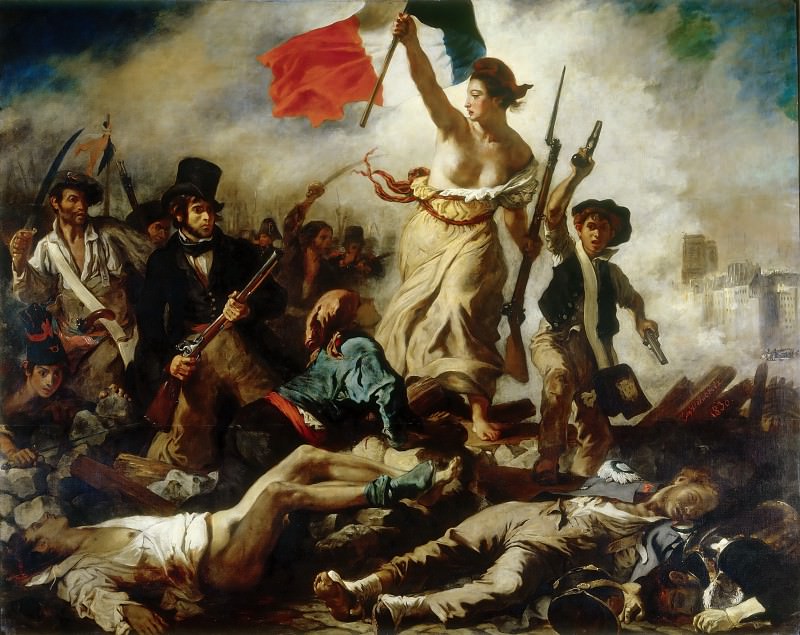Liberty Leading the People 28th July 1830 Ferdinand Victor Eugène Delacroix (1798-1863)
Ferdinand Victor Eugène Delacroix – Liberty Leading the People 28th July 1830
Edit attribution
Image taken from other album: gallerix.org/s/991555443/N/187260602/
Download full size: 4851×3849 px (5,9 Mb)
Painter: Ferdinand Victor Eugène Delacroix
Eugène Delacroix’s 1830 painting has since been referred to as Freedom at the Barricades, but it was originally titled Freedom Leading the People. It is sometimes wrongly thought that this work was inspired by the French Revolution, but in fact Delacroix focused on July 1830, when fierce street fighting was taking place in Paris to overthrow Charles X, the last of the Bourbons, who were so hated by the French people. The young Eugène Delacroix, who positioned himself not as a revolutionary but as a rebel, elated and intoxicated by the fresh air of freedom and victories accomplished, was inspired by the idea of painting a picture of those bloody days and the feat of his people.
Description of Eugène Delacroix’s painting Liberty Leading the People (Liberty at the Barricades)
Eugène Delacroix’s 1830 painting has since been referred to as Freedom at the Barricades, but it was originally titled Freedom Leading the People.
It is sometimes wrongly thought that this work was inspired by the French Revolution, but in fact Delacroix focused on July 1830, when fierce street fighting was taking place in Paris to overthrow Charles X, the last of the Bourbons, who were so hated by the French people.
The young Eugène Delacroix, who positioned himself not as a revolutionary but as a rebel, elated and intoxicated by the fresh air of freedom and victories accomplished, was inspired by the idea of painting a picture of those bloody days and the feat of his people. It took the artist three months to realize the task he had set for himself, and at the end of that period the admiring public saw Freedom Leading the People.
The plot of the painting tells about a fragment of a heated battle, where a detachment of armed rebels through the bodies of their dead comrades and through the whistling of bullets makes its way to the intended goal.
Ahead of them all, with the tricolor flag of the French Republic raised in one hand and a rifle in the other, is a woman. This is Liberty, drawing the men into the attack. She is wearing a Phrygian cap, typical of the Jacobins, and her bare chest, which symbolizes the revolutionaries’ frenzied desire to go bare-chested against the royal bayonets.
The painter’s brushwork flawlessly highlighted the various outfits of the rebels, indicating that the street barricades were fought shoulder to shoulder by members of all walks of life. Delacroix also appears in the painting as the man in the cylinder to the left of Liberty, even though he did not take part in the street battles.
Кому понравилось
Пожалуйста, подождите
На эту операцию может потребоваться несколько секунд.
Информация появится в новом окне,
если открытие новых окон не запрещено в настройках вашего браузера.
You need to login
Для работы с коллекциями – пожалуйста, войдите в аккаунт (open in new window).















COMMENTS: 4 Ответы
На предпоследней банкноте Франции в 100 франков изображены: на одной стороне – Делакруа с кистями (вполне логично), на другой – он же, держащий в руках перо. Но перо – атрибут литератора, Делакруа им не был. Есть ли здесь ошибка?
А, нет, был.
почему "войну" в данном случае свободу во время войны изображают как женщину с Голой грудью?
есть ли этому какое-то объяснение или это всего-лишь задумка изобразителя?
Это только мое мнение, но полагаю, нет более запретной и покрытой мраком темы, чем женская нагота, особенно в то время, соответственно женщина с голой грудью это вызов всем запретам и соответственно, свобода)
You cannot comment Why?
The painting Liberty Leading the People by Eugène Delacroix depicts a tumultuous scene of revolution. At its center, allegorical figure of Liberty, a bare-breasted woman with a Phrygian cap and holding the French tricolor flag, surges forward over a barricade of corpses. She is surrounded by people from various social classes, including a bourgeois man with a top hat, a young boy brandishing pistols, and a worker with a sabre, all united in their fight for freedom. The background shows smoke-filled skies and the distant silhouette of Paris, suggesting the ongoing struggle.
The subtexts of the painting are rich and multifaceted.